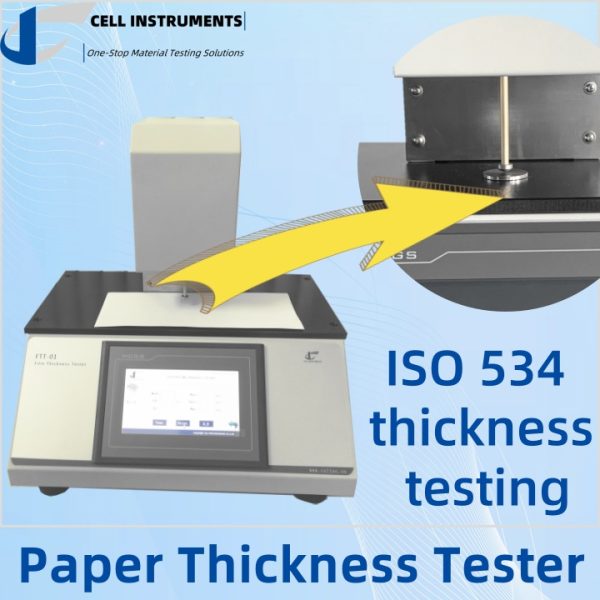Maximizing Quality Control with an ISO 534 Paper Thickness Tester
Accurately measuring paper thickness is a critical part of quality control in industries such as packaging, printing and papermaking. A reliable paper thickness tester ensures that materials meet specific thickness requirements, thereby ensuring consistency and performance of the final product. This article will explore the importance of paper thickness testing, highlight key standards such as ASTM D374 and ISO 534, and recommend advanced testing solutions from Xaar Instruments.
Understanding Paper Thickness Testing
Paper thickness, also known as caliper, is the vertical distance between the two surfaces of a paper. This measurement is critical to determining whether a paper is suitable for a variety of applications such as packaging and printing. A paper thickness tester is an instrument used to measure paper thickness with high accuracy to ensure that the material meets industry standards.
Key Standards for Paper Thickness Testing
There are several standards guiding paper thickness testing to ensure consistent and accurate measurement results across different labs and applications. The most widely recognized standards include
- ASTM D374: This standard outlines methods for measuring the thickness of non-paper materials such as plastic film, but its accuracy guidelines are also referenced in paper thickness testing.
- ISO 534: ISO 534 is a standard specifically for paper and board thickness, and specifies methods for measuring the thickness of paper, board and tissue paper. It provides guidance on the pressure to be applied when measuring and the type of measuring head to be used.
- ASTM D1777: Similar to ISO 534, ASTM D1777 specifies methods for measuring the thickness of textile materials and also applies to certain types of paper.
- ISO 3034: This standard applies to measuring the thickness of corrugated fiberboard to ensure that packaging materials meet specific requirements.
The role of a paper thickness tester
A high-quality paper thickness tester is essential for achieving consistent, reliable measurements. These instruments typically use a displacement method, where a sensor measures the distance between the paper surface and a reference point. The tester must comply with standards such as ISO 534 to ensure accuracy.
When choosing a paper thickness tester, look for the following key features:
- High precision and accuracy: This is essential for reliable measurements with minimal deviation.
- Ease of use: Instruments with intuitive software and a user-friendly interface reduce operating errors and increase efficiency.
- Versatility: The ability to test a wide range of materials, from thin paper to thick cardboard, is essential for industrial applications.
- Durability: Given the harsh operating environments these testers work in, durability is a key factor.
- Paper Thickness Testers from Cell Instruments
For industries that require precise thickness measurement, Cell Instruments offers advanced solutions that meet the stringent requirements of modern quality control. Designed to comply with ISO 534 and ASTM D374 standards, our paper thickness testers provide accurate, repeatable measurements for a wide range of paper products.
Key benefits of Cell Instruments paper thickness testers include
High Accuracy: Ensures accurate measurements every time, meeting the needs of industries that demand the highest precision.
Customizable Settings: Adjust the tester to your specific testing requirements, whether you are dealing with ultra-thin tissue or thick corrugated board.
Durable and Reliable: Rugged and built to last in industrial environments, ensuring long-term performance.
The Importance of ISO 534 Compliance
Complying with ISO 534 is not only about meeting industry standards, but also about ensuring that products perform as expected. In industries such as packaging and printing, even slight variations in paper thickness can affect the performance of the end product. By using an ISO 534 compliant tester, companies can ensure material consistency, reduce waste, and improve overall quality.
Conclusion
In summary, accurate thickness measurement is the cornerstone of quality control in the paper and packaging industries. By investing in a reliable paper thickness tester and adhering to standards such as ISO 534 and ASTM D374, companies can ensure that their products meet the highest quality standards. Cell Instruments’ line of paper thickness testers has the accuracy, versatility, and durability required to meet these needs.
FAQ
Why is paper thickness testing important?
Accurate paper thickness testing ensures consistent product quality, especially in industries such as packaging and printing, where accurate measurements are critical.
What standards should a paper thickness tester comply with?
The most important standards include ISO 534 (paper and board thickness) and ASTM D374 (material thickness measurement).
How does a paper thickness tester work?
It typically uses a displacement method, measuring the distance between the paper surface and a reference point to determine thickness.
What features should I look for when selecting a paper thickness tester?
High accuracy, ease of use, versatility, and durability are key to ensuring accurate and reliable measurements.
Can Cell Instruments’ paper thickness testers measure different materials?
Yes, our testers are designed to be versatile and can measure a wide range of materials from thin paper to thick cardboard.
Related Products
Benchtop Film
Thickness Tester
Related Article
Film
Thickness Tester for Packaging
Lab
Thickness Tester for Paper
Thickness
Tester for Thin Films
Bench
Thickness Tester for Textile
Thickness
Tester Machine for Textiles

